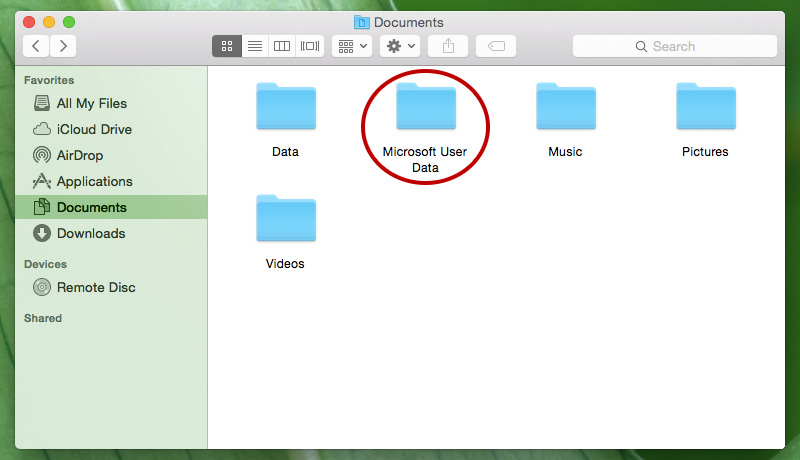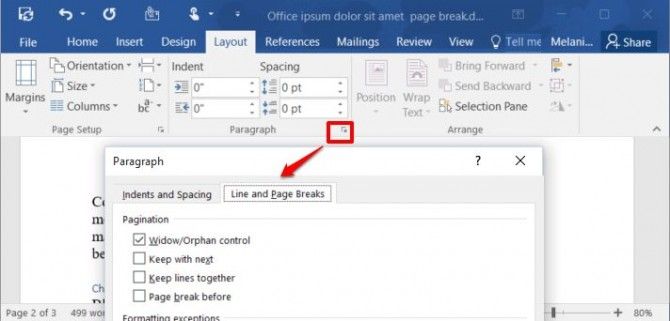Microsoft User Data Folder Mac 2017
- Outlook Data Files (.pst) created by using Outlook 2013 or Outlook 2016 are typically saved on your computer in the DocumentsOutlook Files folder. If you upgraded to Outlook on a computer that already had data files that were created in Microsoft Office Outlook 2007 or earlier, these files are saved in a different location in a hidden folder at drive:UsersuserAppDataLocalMicrosoftOutlook.
- Outlook Data Files (.pst) created by using Outlook 2013 or Outlook 2016 are typically saved on your computer in the Documents Outlook Files folder. If you upgraded to Outlook on a computer that already had data files that were created in Microsoft Office Outlook 2007 or earlier, these files are saved in a different location in a hidden folder at drive: Users user AppData Local Microsoft Outlook.
- Dec 16, 2016 Where is Outlook for Mac 2011 data stored? I need to find where the Outlook data is stored in order to restore it with Time Machine. I went to the MUD folder and found Outlook Identities 2011, but the only items in it are 2008 Identities from when I was using Entourage.
- Fixed: where are my Office 365 AutoRecovery files?, Microsoft User Data, Microsoft Word. Default autosave folder location? Because my Mac crashes all the.
- Mar 19, 2020 I just upgraded from Office 2011 for the Mac to office 2016 (via an office 365 subscription). Can I delete the old 'microsoft user data' folder in my documents folder. My understanding is that office 2016 doesn't need it. Since I didn't use Outlook, the folder is small, but it is still clutter I'd like to get rid of if not needed.
- Microsoft User Data Mac
- Microsoft User Data File
- Microsoft User Data Folder Mac 2017 Crack
- Mac User Folder Location
- Microsoft User Data Folder Mac 2017 Free
Windows Migration Assistant transfers your contacts, calendars, email accounts and more from a PC. It migrates this data to the appropriate places on your Mac. After migrating data to your Mac, authorise your computer for iTunes Store purchases. It’s important to authorise before you sync or play content that you download from the iTunes Store.
Jul 05, 2017 For example, the location of my “Work” profile in Windows 10 is actually C: Users Lori AppData Local Google Chrome User Data Profile 3. You can select the path and copy it and paste it into File Explorer in Windows, the Finder on OS X, or into a file manager like Nautilus in Linux to access that folder.
If you're migrating from one Mac to another Mac, follow the steps to move your content to a new Mac.
Before you begin
To prepare for a smooth migration:
- Make sure that Windows is up to date. Migration Assistant works with Windows 7 and later.
- Make sure that you know the name and password of an administrator account on your PC.
- Connect your Mac and PC to the same network, such as your home Wi-Fi network. Or connect an Ethernet cable between the ports on your Mac and PC to create a direct network connection. Some Mac models require an Ethernet adapter, such as the Belkin USB-C to Gigabit Ethernet Adapter or Apple Thunderbolt to Gigabit Ethernet Adapter.
- If you're using Microsoft OneDrive on your PC, follow Microsoft's instructions for uninstalling OneDrive before continuing. You can reinstall OneDrive after migration is complete.
Then use the check disk (chkdsk) utility on your PC to make sure that your Windows hard drive doesn’t have any issues:
- Right-click the Start button, then click Run.
- Type
cmdand press Enter. Command Prompt opens. - At the prompt, type
chkdskand press Enter. - If the utility reports that it found problems, type the following, where drive is the letter that represents your Windows startup disk, such as D:
- Press Enter.
- At the prompt, type
Y, then restart your PC. - Repeat this process until the check disk utility reports no issues. If the utility can't fix every issue that it finds, you might need to have your PC serviced. Then migrate your data to your Mac.
Move your data
This section guides you through migration, post-migration, and what to do if the steps don’t work for you.
How to move your information from a PC to your Mac
- On your PC, download and install the appropriate Windows Migration Assistant, based on the version of macOS on your Mac:
- Windows Migration Assistant for macOS Mojave or later
- Windows Migration Assistant for macOS Sierra and High Sierra
- Windows Migration Assistant for OS X El Capitan or earlier
- Quit any open Windows apps.
- Open Windows Migration Assistant, then click Continue.
- Start up your Mac. Setup Assistant automatically opens the first time you turn on your Mac. If you’ve already set up your Mac, open Migration Assistant, which is in the Utilities folder of your Applications folder.
- On your Mac, follow the onscreen prompts until you get to the migration pane of the assistant. Select the option to transfer your information 'From a Windows PC', then click Continue.
- When prompted, enter an administrator name and password.
- Click Continue to close any other open apps.
- In the migration window on your Mac, select your PC from the list of available computers. Then wait for the PC to show the same passcode that your Mac shows.
- When both computers display the same passcode, click Continue on your PC and Mac.
- Your Mac scans the drives on your PC to build a list of information to migrate. When the scan is complete, select the information that you want to migrate to your Mac and click Continue. Learn about some of the data that you can transfer.
You can watch the progress and estimated time remaining on both the PC and your Mac. They tell you when migration is complete.
After you move your data
When migration completes, close Windows Migration Assistant on your PC. Then log in to the new user account on your Mac. The first time you log in to a user account migrated from your PC, you’re asked to set a password. You can use the same password that you used on your PC, or create a new password.
After logging in to the user account that you migrated, your computer for iTunes Store purchases. It’s important to authorise before you sync or play content downloaded from the iTunes Store.
If you have issues moving your data
- Quit all open apps on your PC, then try migrating your content again. For example, you can press Alt-Tab to choose an open application, then press Alt-F4 to quit it.
- If your PC doesn't appear in the Setup Assistant or Migration Assistant window on your Mac, make sure the computers are connected to the same network. You can create an network by connecting a single Ethernet cable between your Mac and PC. If that doesn't help, check for firewall software on your PC and turn it off. Firewall software can block network ports needed during migration.After migration completes, you can turn firewall software on again.
- If Migration Assistant doesn’t open on your PC, turn off any antivirus software on your PC. Then try to open Migration Assistant again. After migration completes. You can turn that software on again.
- If you still can't migrate your information successfully, you can use an external drive or file sharing to manually copy important data to your Mac.
What data can I transfer?
Migration Assistant lets you choose the data to move to your Mac. Here’s what moves over for specific apps and data types:
Email, contacts and calendar information
Email messages, email-account settings, contacts and appointments move based on which version of Windows you're using and which accounts you have.
Outlook1
Data from 32-bit versions of Outlook in Windows 7 and later move as follows:
- People move to Contacts2
- Appointments move to the Calendar app
- IMAP and Exchange settings and messages move to the Mail app
- POP settings and messages move to Mail2
Windows Live Mail
Data from Windows Live Mail in Windows 7 and later moves as follows:
- IMAP settings and messages move to Mail
- POP settings and messages move to Mail2
Windows Mail
Data from Windows Mail in Windows 7 and later (excluding Windows 8) move as follows:
- IMAP settings and messages move to Mail
- POP settings and messages move to Mail2
- People move to Contacts
Microsoft User Data Mac
Bookmarks
Bookmarks from Internet Explorer, Safari for Windows, and Firefox move to Safari.
System settings
Language and location settings and custom desktop pictures move to System Preferences.Your web browser homepage moves to Safari preferences.
Pictures
Photos and other images move to your home folder. You can then add them to Photos, or open Photos and let it search your Mac for photos to import.
Microsoft User Data File

iTunes content
Migration Assistant transfers your iTunes media as follows: music to the Apple Music app, videos to the Apple TV app, podcasts to the Apple Podcasts app and audiobooks to the Apple Books app. What happened to iTunes?
Other files
Migration Assistant also moves these files:
Microsoft User Data Folder Mac 2017 Crack
- Files from the top-level folder of the currently logged-in user’s home directory
- Non-system files located in the Windows or Program Files folders
- Top-level folders located on the Windows system disk and other attached disks
Mac User Folder Location
1. Migration Assistant doesn’t support 64-bit versions of Outlook. You can manually migrate Mail, Contacts or Calendars from Outlook 2013 or Outlook 2016 by signing in and entering the content on your Mac manually.
Progress bar, close or cancel the progress bar and try again.On the first installation screen, select Continue to begin the installation process.Review the software license agreement, and then click Continue.Select Agree to agree to the terms of the software license agreement.Choose how you want to install Office and click Continue.Review the disk space requirements or change your install location, and then click Install. If you're stuck at the Verifying. Tip: If you see an error that says the MicrosoftOffice2016Installer.pkg can't be opened because it is from an unidentified developer, wait 10 seconds and then try double-clicking the installer package again. Microsoft word 2013 free trial for mac. If so, follow the prompts to activate Office.If you need activation help, see.
Microsoft User Data Folder Mac 2017 Free
2. Migration Assistant transfers only the Mail or Contacts data that belongs to the logged-in Windows user. To transfer data from another user account, use Migration Assistant again while you’re logged in to another Windows account. Each time you migrate, your Mac creates a new user account.
